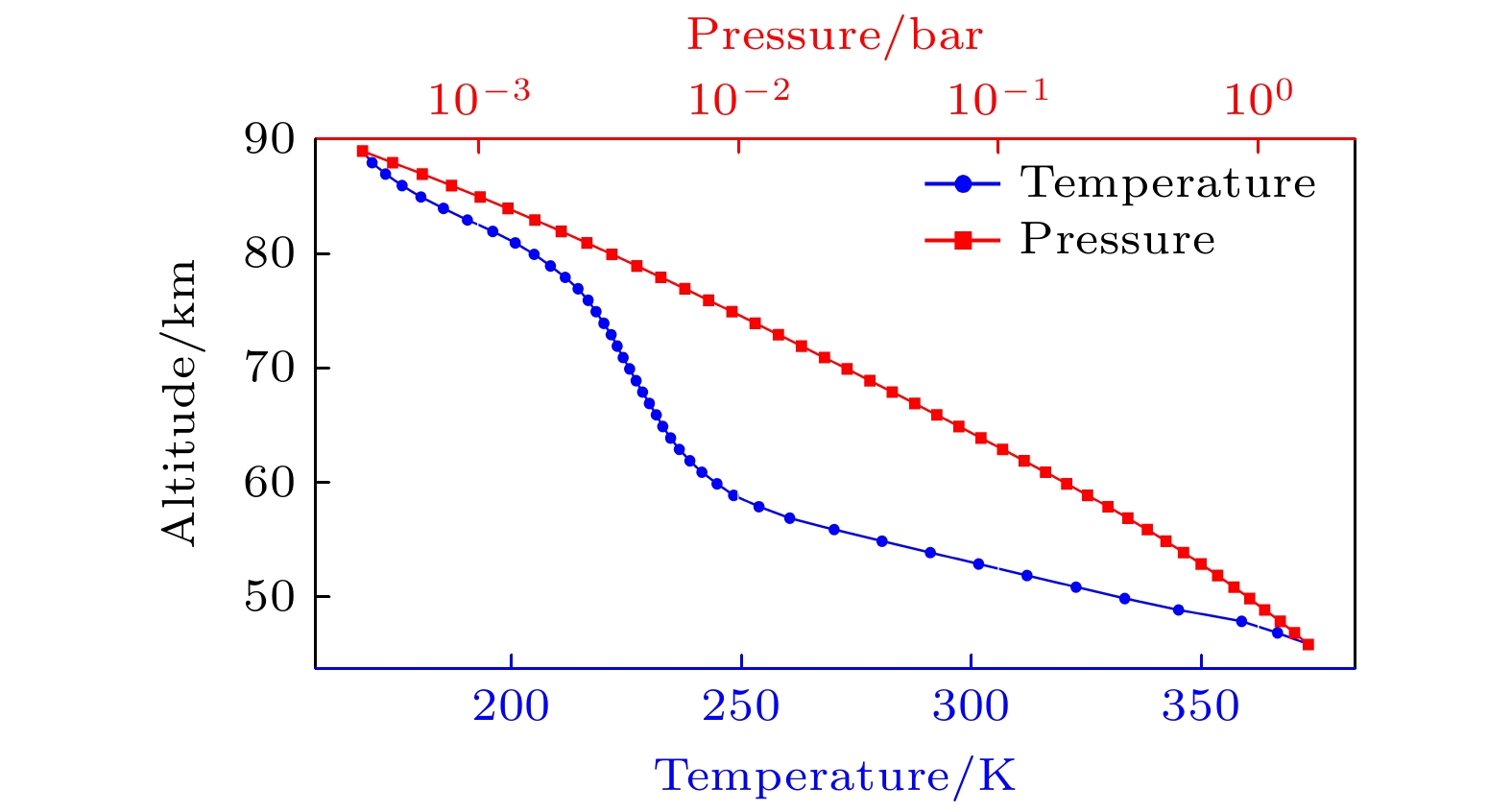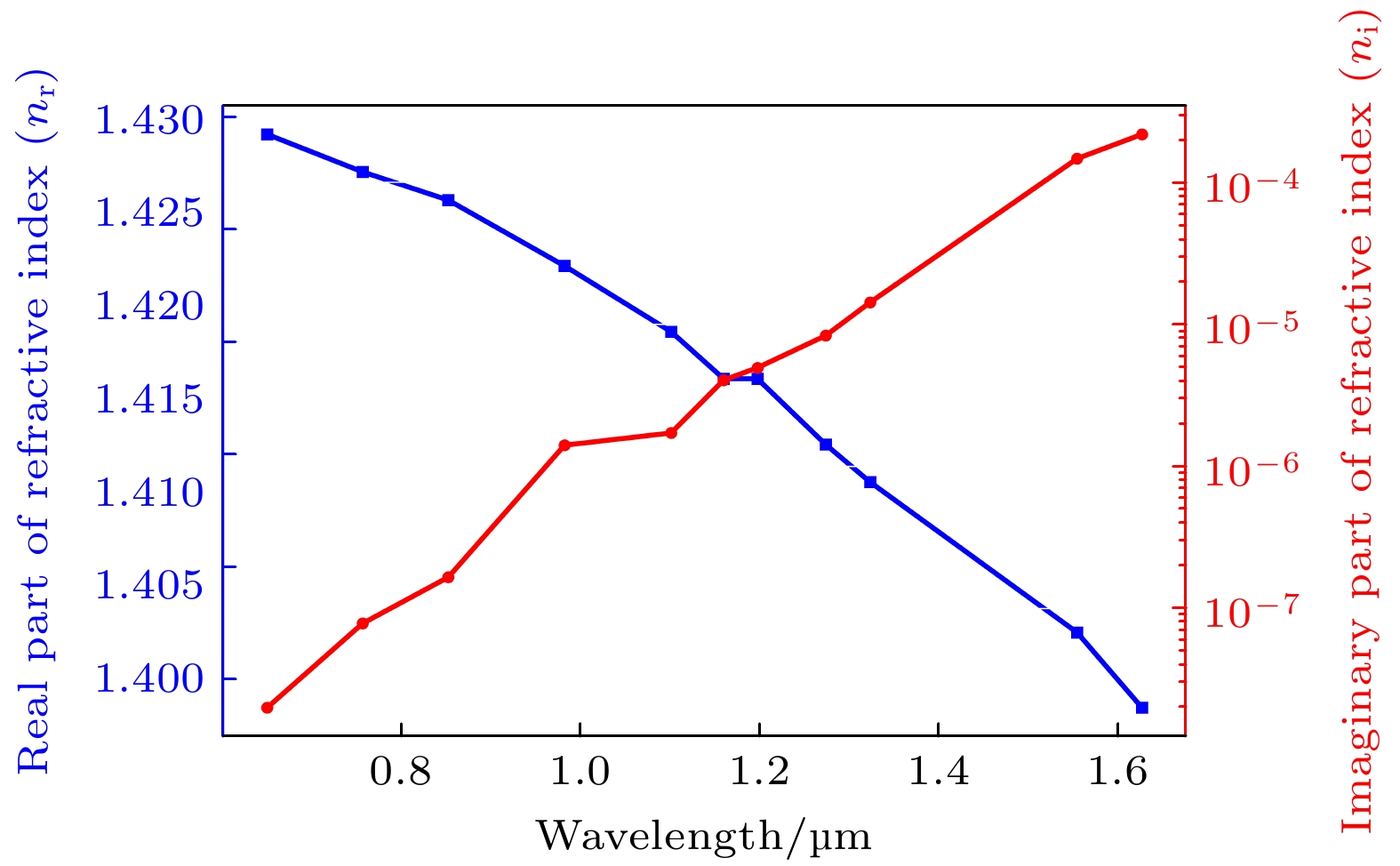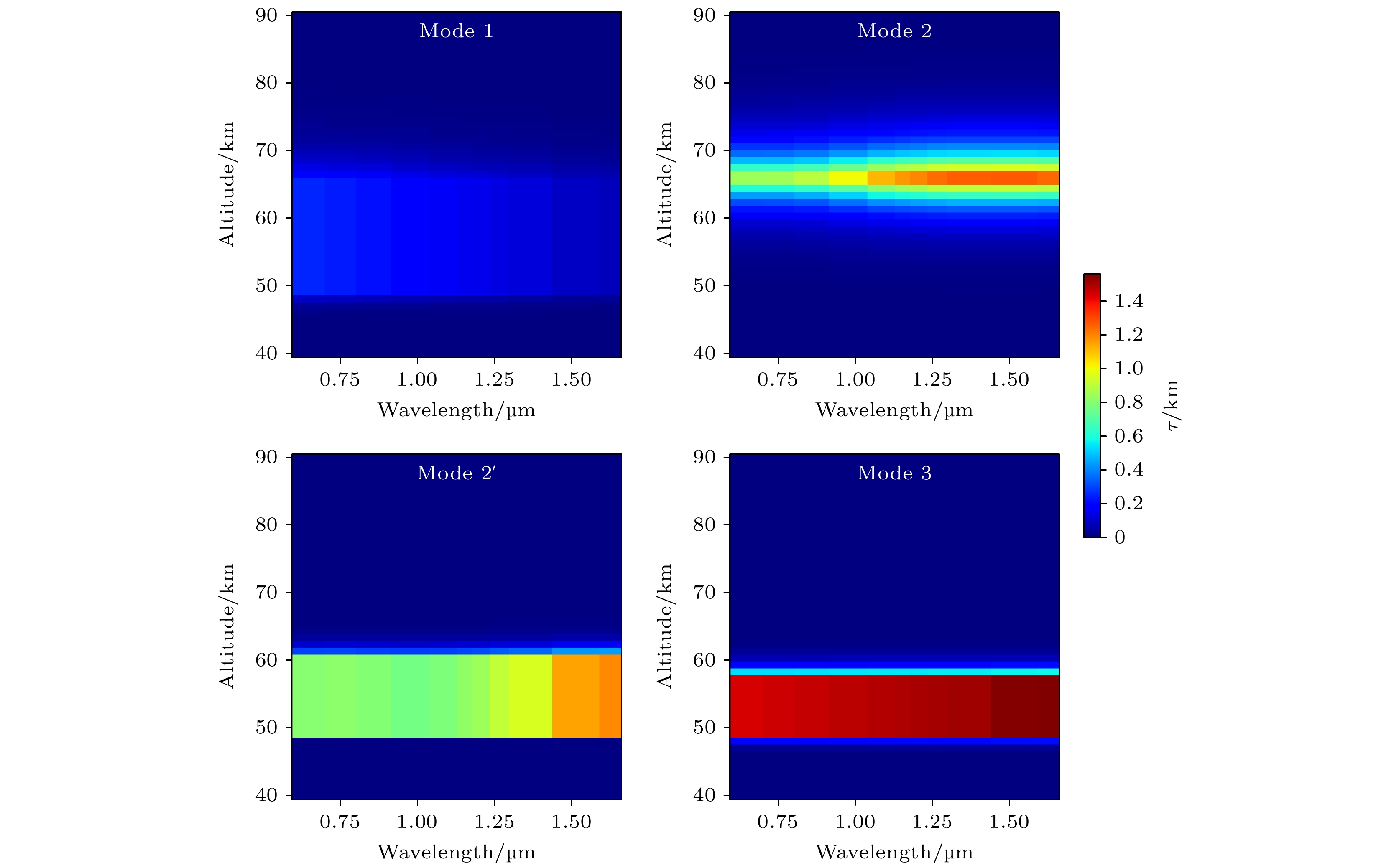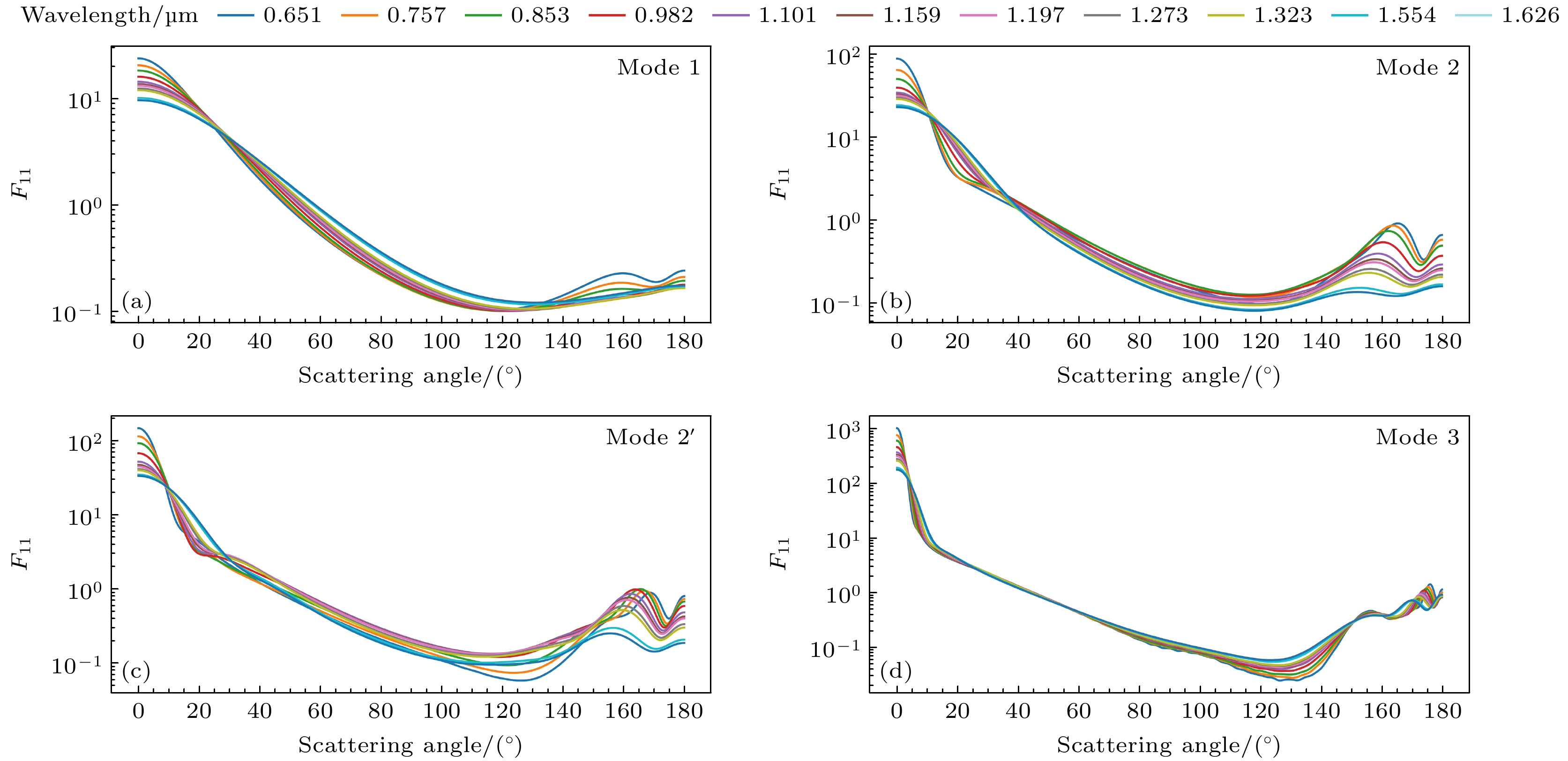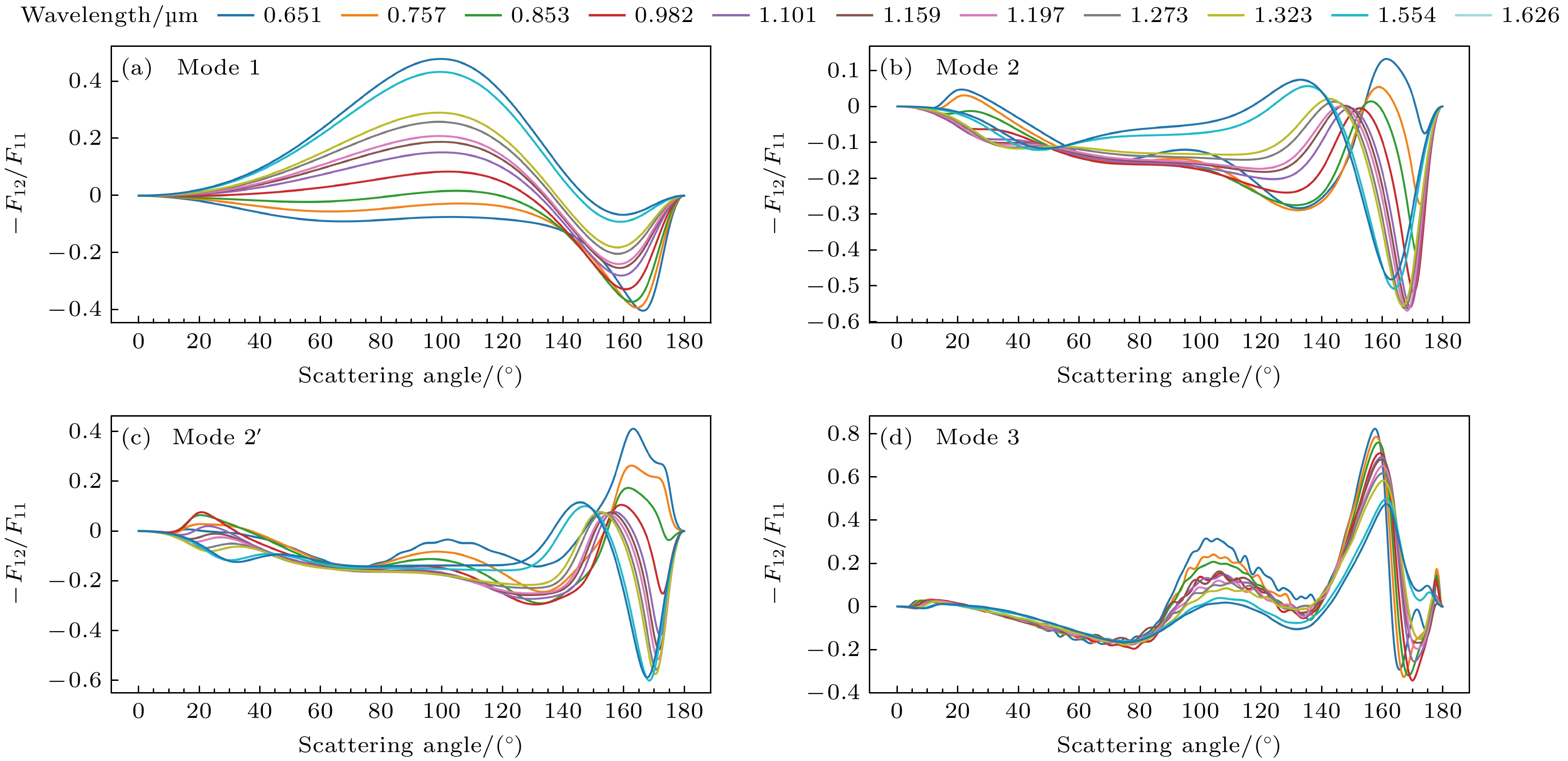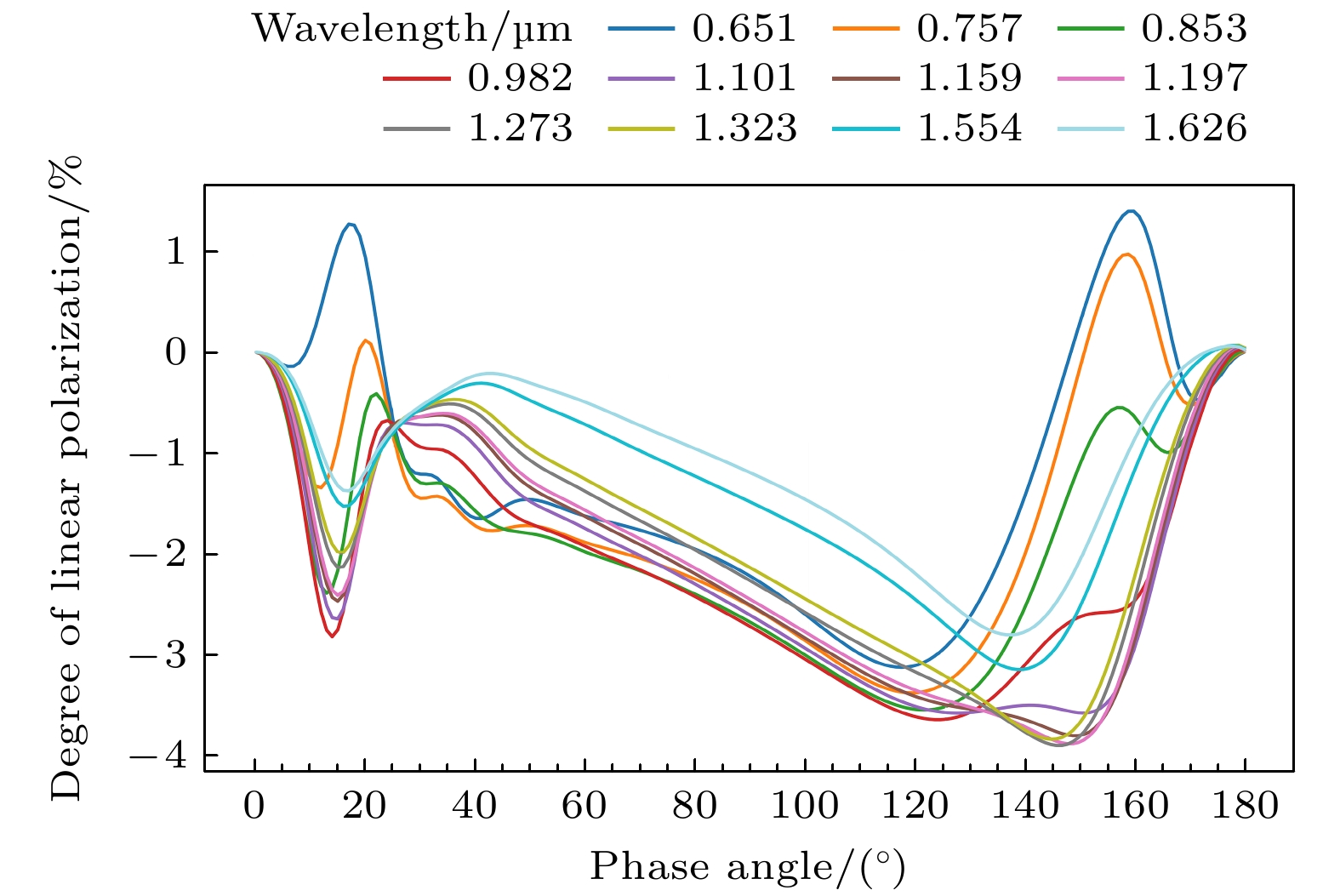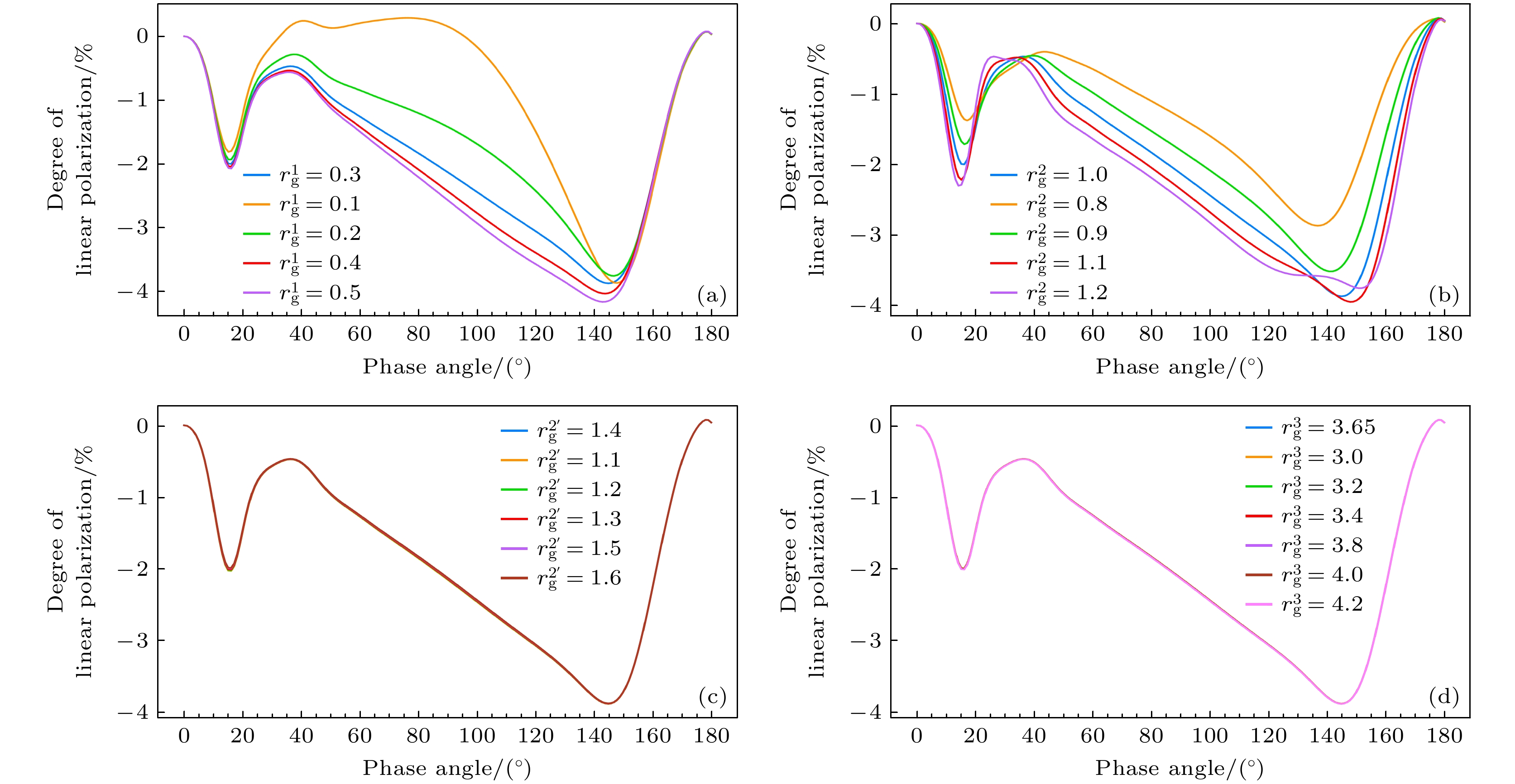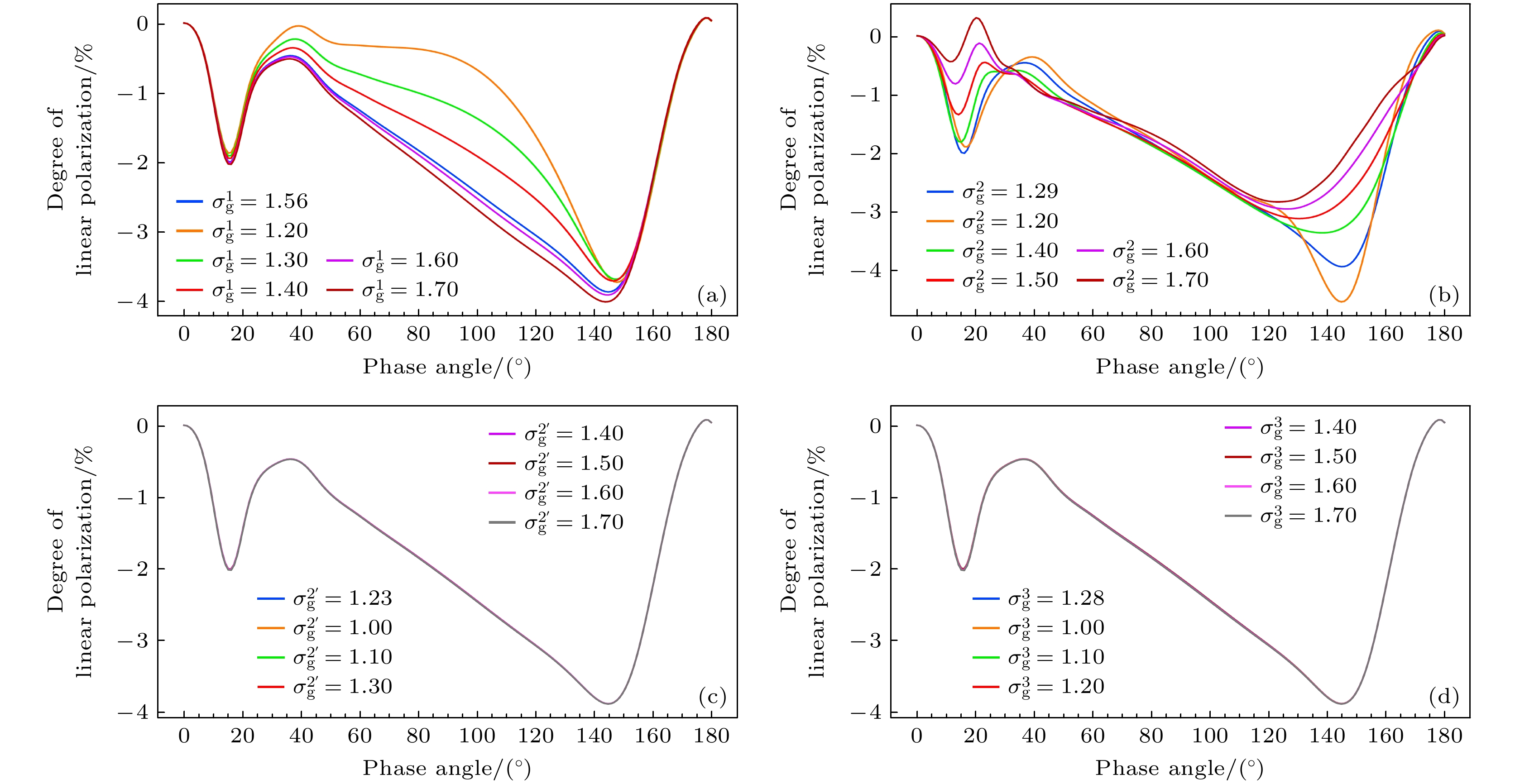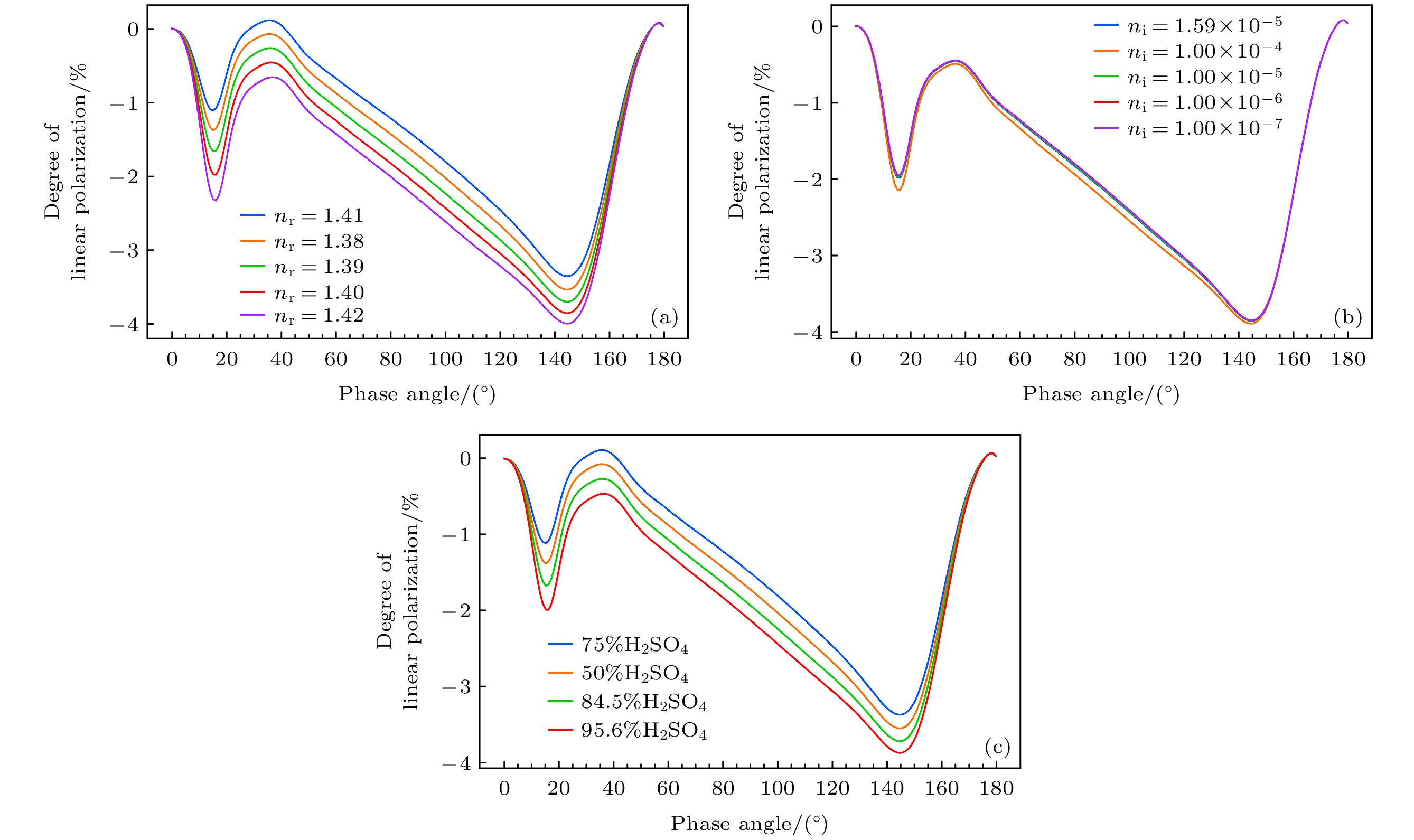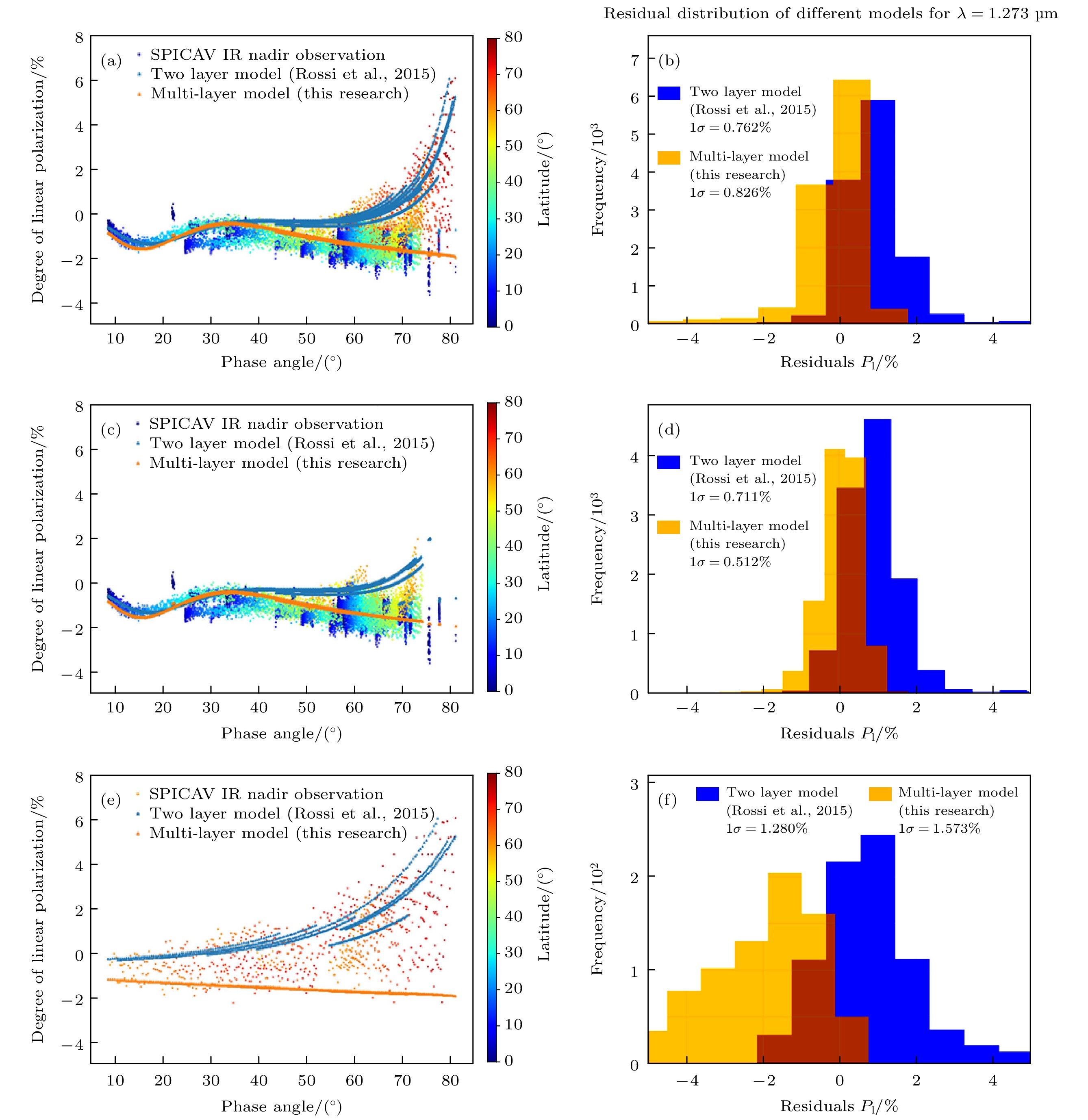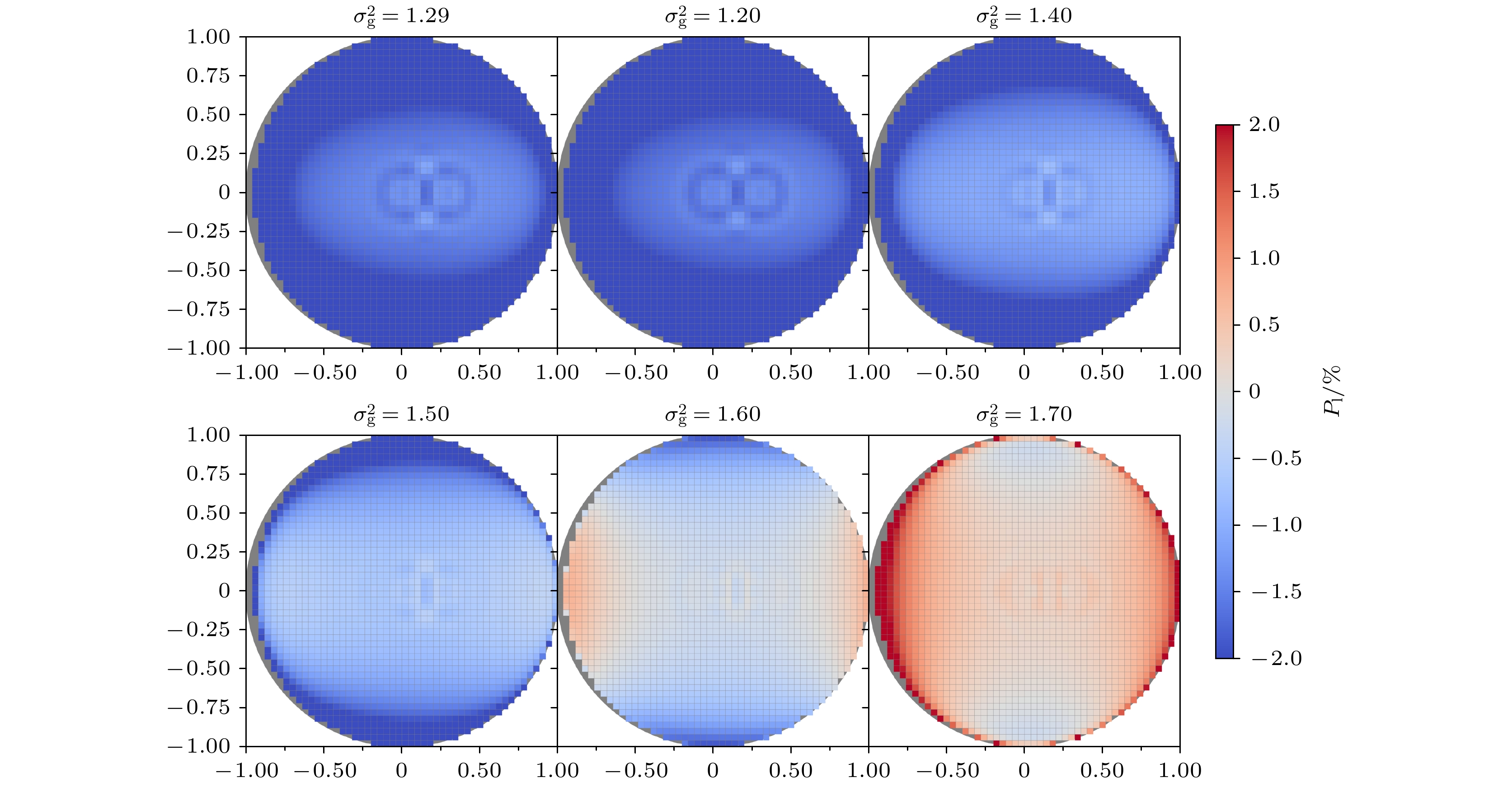-
The PyMieDAP radiative transfer model is used in this work to simulate the radiation characteristics of Venus clouds and haze, thereby investigating how their microphysical characteristics affect linear polarization by comparing near-infrared polarization data from the SPICAV IR instrument on the Venus Express. The results show that single-scattered fluxes of the four particle modes decrease in a phase angle range from 0° to 120°, but increase near 160°. Mode 1 particles (upper haze) exhibit Rayleigh scattering characteristics, with polarization changing from positive to negative as the wavelength increases. Mode 2 and Mode 2' particles display two positive polarization peaks near 15° and 160°, respectively, with polarization reversing in the near-infrared. Mode 3 particles show oscillations in polarization near 105°, flipping from positive to negative between 155° and 165°. The primary polarization peak occurs near 15°, corresponding to the main rainbow, while a secondary peak between 150° and 160° is attributed to anomalous diffraction. The microphysical properties of upper clouds and haze (Mode 1 and Mode 2) significantly affect the linear polarization of Venus, while those of lower clouds (Mode 2' and Mode 3) have a minimum influence. A reduction in Mode 1 column density increases the polarization peak at the main rainbow, while an increase in Mode 2 column density has the opposite effect. Changes in modal radius enhance polarization peaks for Mode 1 and Mode 2, while increasing geometric standard deviation reduces polarization peaks and shifts their phase angles. The real part of the complex refractive index has a greater influence on polarization than the imaginary part. Simulations using the multilayer model show better agreement with SPICAV IR data and consistency with the larger particle sizes in Venus’ haze. The integrated linear polarization across the Venus disk varies with wavelength and phase angle, with the polarization being higher at the disk's edge. The variation in cloud coverage also influences polarization, with areas with fewer clouds exhibiting higher values. In the future, further research will be conducted on the influence of cloud and haze parameters on line polarization, for the inversion of these parameters is beyond the scope of this work. -
Keywords:
- Venusian clouds and haze /
- linear polarization /
- sensitivity analysis /
- microphysical properties
[1] Lyot B 1929 Ph. D. Dissertation (Paris: Université de Paris Paris
[2] Coffeen D L 1969 Astronom. J. 74 446
 Google Scholar
Google Scholar
[3] Dyck H, Forbes F, Shawl S 1971 Astronom. J. 76 901
 Google Scholar
Google Scholar
[4] Hansen J E, Hovenier J 1974 J. atmos. Sci. 31 1137
 Google Scholar
Google Scholar
[5] Esposito L, Knollenberg R, Marov M, Toon O, Turco R 1983 The Clouds and Hazes of Venus (University of Arizona Press) pp484−564
[6] Pollack J B, Dalton J B, Grinspoon D, Wattson R B, Freedman R, Crisp D, Allen D A, Bezard B, DeBergh C, Giver L P 1993 Icarus 103 1
 Google Scholar
Google Scholar
[7] Rossi L, Marcq E, Montmessin F, Fedorova A, Stam D, Bertaux J L, Korablev O 2015 Planet. Space Sci. 113 159
 Google Scholar
Google Scholar
[8] 李宜奇, 孙晓兵, 黄红莲, 刘晓, 提汝芳, 郑小兵, 樊依哲, 余海啸, 韦祎晨, 王宇轩, 王宇瑶 2024 红外与毫米波学报 43 657
 Google Scholar
Google Scholar
Li Y Q, Sun X B, Huang H L, Liu X, Ti R F, Zheng X B, Fan Y Z, Yu H X, Wei Y C, Wang Y X, Wang Y Y 2024 J. Infrared Millim. W. 43 657
 Google Scholar
Google Scholar
[9] Hansen J E, Travis L D 1974 Space Sci. Rev. 16 527
 Google Scholar
Google Scholar
[10] Stam D 2008 Astron. Astrophys. 482 989
 Google Scholar
Google Scholar
[11] Stam D, Hovenier J, Waters L 2004 Astron. Astrophys. 428 663
 Google Scholar
Google Scholar
[12] Bertaux J L, Nevejans D, Korablev O, et al. 2007 Planet. Space Sci. 55 1673
 Google Scholar
Google Scholar
[13] Svedhem H, Titov D, McCoy D, Lebreton J P, Barabash S, Bertaux J L, Drossart P, Formisano V, Häusler B, Korablev O 2007 Planet. Space Sci. 55 1636
 Google Scholar
Google Scholar
[14] Korablev O, Fedorova A, Bertaux J L, et al. 2012 Planet. Space Sci. 65 38
 Google Scholar
Google Scholar
[15] Rossi L, Berzosa-Molina J, Stam D M 2018 Astron. Astrophys. 616 A147
 Google Scholar
Google Scholar
[16] de Haan J F, Bosma P, Hovenier J 1987 Astron. Astrophys. 183 371
[17] Peterson P 2009 Int. J. Comput. Sci. Eng. 4 296
 Google Scholar
Google Scholar
[18] Zasova L, Moroz V, Linkin V, Khatuntsev I, Maiorov B 2006 Cosmic Res. 44 364
 Google Scholar
Google Scholar
[19] Braak C, De Haan J, Hovenier J, Travis L 2002 J. Geophys. Res. Planets 107 5
 Google Scholar
Google Scholar
[20] Knibbe W J J, de Haan J F, Hovenier J W, Travis L D 1998 J. Geophys. Res. Planets 103 8557
 Google Scholar
Google Scholar
[21] Palmer K F, Williams D 1975 Appl. Opt. 14 208
 Google Scholar
Google Scholar
[22] Haus R, Kappel D, Arnold G 2015 Planet. Space Sci. 117 262
 Google Scholar
Google Scholar
[23] Mie G 1908 Ann. Phys. 330 377
 Google Scholar
Google Scholar
[24] van de Hulst H C Van de Hulst H C, Twersky V 1957 Physics Today 10 28
 Google Scholar
Google Scholar
-
图 9 线偏振度对四种模式粒子柱密度变化的敏感性( $ {V}_{0}^{i} $代表粒子的柱密度(i =1 , 2, 2', 3), 对应4种不同的粒子模式)
Figure 9. Sensitivity of linear polarization degree to changes in particle column density in four modes ($ {V}_{0}^{i} $ represents the column density of the particle, i = 1, 2, 2', 3, corresponding to four different particle modes).
图 10 线偏振度对4种模式粒子模态半径变化的敏感性($ r_{\text{g}}^i $代表粒子的模态半径(i = 1, 2, 2', 3), 对应4种不同的粒子模式)
Figure 10. Sensitivity of linear polarization degree to changes in modal radius of particles in four modes ($ r_{\text{g}}^i $ represents the modal radius of the particle, i = 1, 2, 2', 3, corresponding to four different particle modes).
图 11 线偏振度对四种模式粒子几何标准差变化的敏感性($ \sigma _{\text{g}}^i $代表粒子的几何标准差(i = 1, 2, 2', 3), 对应4种不同的粒子模式)
Figure 11. Sensitivity of linear polarization to the change of geometric standard deviation of particles in four modes ($ \sigma _{\text{g}}^i $ represents the geometric standard deviation of particles, i = 1, 2, 2', 3, corresponding to four different particle modes).
图 12 线偏振度对粒子复折射率和H2SO4浓度变化的敏感性($ {n}_{{\mathrm{r}}} $为折射率实部, $ {n}_{{\mathrm{i}}} $为折射率虚部)
Figure 12. Sensitivity of linear polarization degree to changes in particle complex refractive index and H2SO4 concentration ($ {n}_{{\mathrm{r}}} $ is the real part of the refractive index, $ {n}_{{\mathrm{i}}} $ is the imaginary part of the refractive index).
图 13 (a) 多层和双层模型的模拟结果与北半球SPICAV IR偏振数据的对比; (b)多层和双层模型模拟值与北半球SPICAV IR实测偏振数据间残差的1σ区间; (c), (d)对应北半球中低纬地区(0—60°N); (e), (f)对应北半球高纬地区(60°N—80°N)
Figure 13. (a) Comparison of simulation results of multi-layer and double-layer models with SPICAV IR polarization data in the Northern Hemisphere; (b) 1σ interval of residuals between simulation values of multi-layer and double-layer models and measured polarization data of SPICAV IR in the Northern Hemisphere; (c), (d) correspond to the middle and low latitudes of the Northern Hemisphere (0−60°N); (e), (f) correspond to the high latitudes of the Northern Hemisphere (60°N−80°N)
表 1 SPICAV IR仪器SW和LW通道对应波长
Table 1. Wavelengths of SW and LW channels of SPICAV IR instrument.
通道 DOTS处波长/nm SW 650.8, 757.2, 852.7, 982.3 LW 1101.1, 1159.6, 1197.3, 1273.4, 1323.0, 1553.7, 1626.0 表 2 金星标准云模型的单模态参数
Table 2. Single-mode parameters of Venus standard cloud model.
模式 1 2 2' 3 峰值高度下限 zb/km 49.0 65.0 49.0 49.0 恒定峰值粒子数的层厚 zc/km 16.0 1.0 11.0 8.0 上层标高 Hup/km 3.5 3.5 1.0 1.0 下层标高 Hlo/km 1.0 3.0 0.1 0.5 峰值高度处的粒子数密度 N0/cm–3 193.5 100 50 14 粒子总柱浓度/(105 cm–2) 3966.19 749.56 605.0 133.0 -
[1] Lyot B 1929 Ph. D. Dissertation (Paris: Université de Paris Paris
[2] Coffeen D L 1969 Astronom. J. 74 446
 Google Scholar
Google Scholar
[3] Dyck H, Forbes F, Shawl S 1971 Astronom. J. 76 901
 Google Scholar
Google Scholar
[4] Hansen J E, Hovenier J 1974 J. atmos. Sci. 31 1137
 Google Scholar
Google Scholar
[5] Esposito L, Knollenberg R, Marov M, Toon O, Turco R 1983 The Clouds and Hazes of Venus (University of Arizona Press) pp484−564
[6] Pollack J B, Dalton J B, Grinspoon D, Wattson R B, Freedman R, Crisp D, Allen D A, Bezard B, DeBergh C, Giver L P 1993 Icarus 103 1
 Google Scholar
Google Scholar
[7] Rossi L, Marcq E, Montmessin F, Fedorova A, Stam D, Bertaux J L, Korablev O 2015 Planet. Space Sci. 113 159
 Google Scholar
Google Scholar
[8] 李宜奇, 孙晓兵, 黄红莲, 刘晓, 提汝芳, 郑小兵, 樊依哲, 余海啸, 韦祎晨, 王宇轩, 王宇瑶 2024 红外与毫米波学报 43 657
 Google Scholar
Google Scholar
Li Y Q, Sun X B, Huang H L, Liu X, Ti R F, Zheng X B, Fan Y Z, Yu H X, Wei Y C, Wang Y X, Wang Y Y 2024 J. Infrared Millim. W. 43 657
 Google Scholar
Google Scholar
[9] Hansen J E, Travis L D 1974 Space Sci. Rev. 16 527
 Google Scholar
Google Scholar
[10] Stam D 2008 Astron. Astrophys. 482 989
 Google Scholar
Google Scholar
[11] Stam D, Hovenier J, Waters L 2004 Astron. Astrophys. 428 663
 Google Scholar
Google Scholar
[12] Bertaux J L, Nevejans D, Korablev O, et al. 2007 Planet. Space Sci. 55 1673
 Google Scholar
Google Scholar
[13] Svedhem H, Titov D, McCoy D, Lebreton J P, Barabash S, Bertaux J L, Drossart P, Formisano V, Häusler B, Korablev O 2007 Planet. Space Sci. 55 1636
 Google Scholar
Google Scholar
[14] Korablev O, Fedorova A, Bertaux J L, et al. 2012 Planet. Space Sci. 65 38
 Google Scholar
Google Scholar
[15] Rossi L, Berzosa-Molina J, Stam D M 2018 Astron. Astrophys. 616 A147
 Google Scholar
Google Scholar
[16] de Haan J F, Bosma P, Hovenier J 1987 Astron. Astrophys. 183 371
[17] Peterson P 2009 Int. J. Comput. Sci. Eng. 4 296
 Google Scholar
Google Scholar
[18] Zasova L, Moroz V, Linkin V, Khatuntsev I, Maiorov B 2006 Cosmic Res. 44 364
 Google Scholar
Google Scholar
[19] Braak C, De Haan J, Hovenier J, Travis L 2002 J. Geophys. Res. Planets 107 5
 Google Scholar
Google Scholar
[20] Knibbe W J J, de Haan J F, Hovenier J W, Travis L D 1998 J. Geophys. Res. Planets 103 8557
 Google Scholar
Google Scholar
[21] Palmer K F, Williams D 1975 Appl. Opt. 14 208
 Google Scholar
Google Scholar
[22] Haus R, Kappel D, Arnold G 2015 Planet. Space Sci. 117 262
 Google Scholar
Google Scholar
[23] Mie G 1908 Ann. Phys. 330 377
 Google Scholar
Google Scholar
[24] van de Hulst H C Van de Hulst H C, Twersky V 1957 Physics Today 10 28
 Google Scholar
Google Scholar
-
 2025年第74卷第9期094201《近红外波长处金星(盘)线偏振度的敏感性分析》补充材料.pdf
2025年第74卷第9期094201《近红外波长处金星(盘)线偏振度的敏感性分析》补充材料.pdf

Catalog
Metrics
- Abstract views: 999
- PDF Downloads: 35
- Cited By: 0
















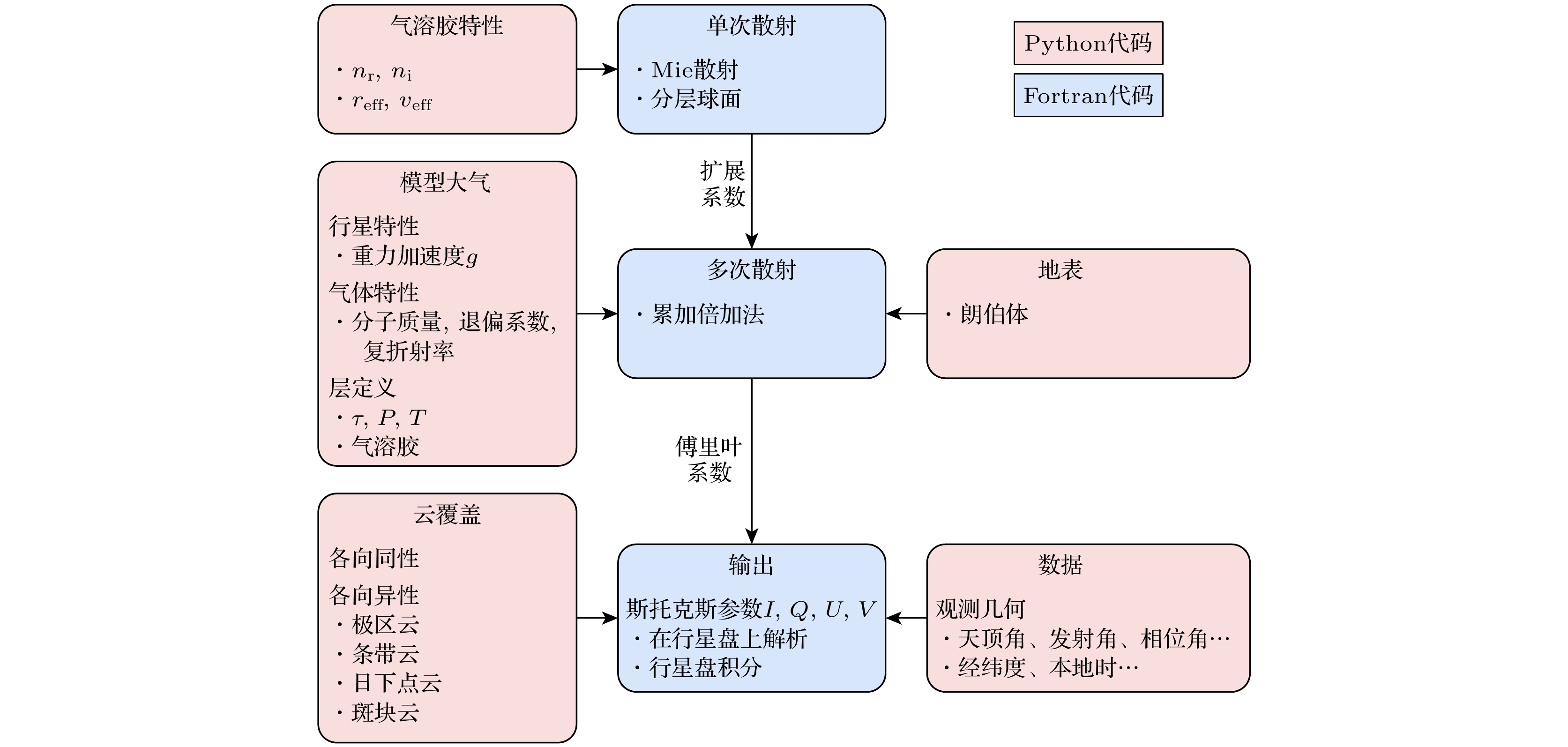
 DownLoad:
DownLoad:
